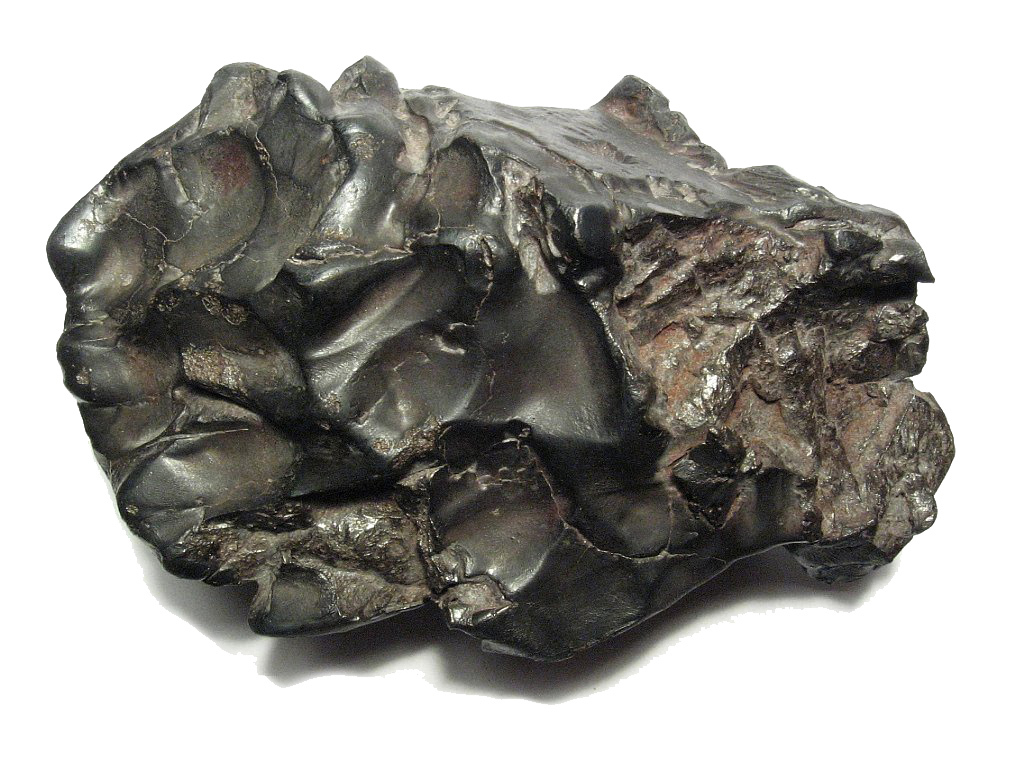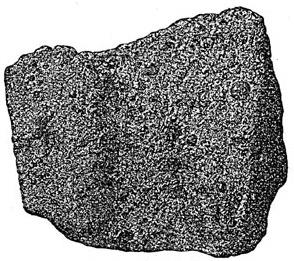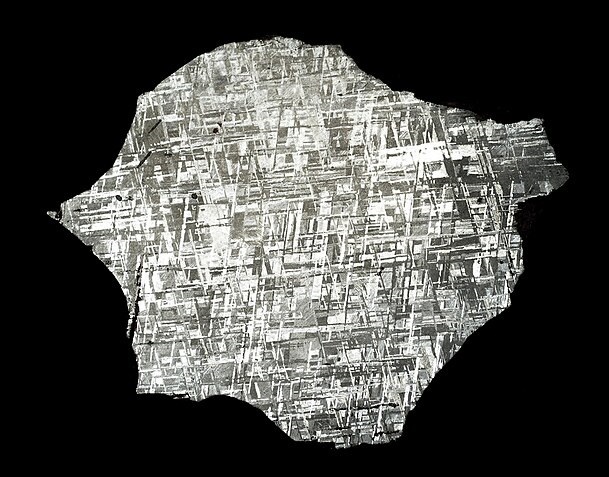Pozor, keška sa nachádza v múzeu, kde je platený vstup podľa zverejneného cenníka. Múzeum je otvorené podľa oficiálnych otváracích hodín.
Na odlov kešky potrebujete navštíviť múzeum a zodpovedať otázky. Meteority sú na druhom poschodí, priamo oproti schodisku. Expozícia je však tvorená tak, aby ste šli najprv do dverí vpravo po výjdení schodiska a obišli budovu. Odporúčam prejsť celú expozíciu, je krásna. Po vstupe sú k nahliadnutiu mnohé skameneliny naprieč vývojovými obdobiami zeme, následne súčasná fauna a nakoniec geologická expozícia, v ktorej nájdete aj meteority.
V expozícii priamo oproti schodisku nájdete dve menšie vitríny, tá vľavo obsahuje minerály podobné meteoritom a tá vpravo meteority. V prípade podobných minerálov sa jedná o železnú trosku a odpad po tavení, hematiti, titanomagnetit pyrit, oxidy železa, železo v čadiči a silikátová tavenina, billitonit a dokonca aj vltavíny z Čiech a Moravy. V pravej vitríne sa nachádza množstvo železných meteoritov (vzorky 1-10), dva kamenné meteority (12, 13) a kamenno-železný meteorit (vzorka 11). Vzorky 2, 5 a 10 sú krásnou ukážkou Widmanstättenovźch obrazcov.
Otázky:
- Pozorujte meteorit Košice (Vzorka 12 vpravo). Opíšte jeho tvar, veľkosť, farbu. Môžete na základe týchto vlastností dedukovať jeho pôvodnú veľkosť, alebo nie?
- Podľa pozorovania tohto meteoritu zdôvodnite, prečo sa jedná o kamenný meteorit. Je tento meteorit zásadne odlišný od pozemských kameňov?
- Opíšte aké sú jednoznačné rozdiely medzi kamenným a železným meteoritom.
- Pozorujte vzorky 2, 5 a/alebo 10. Opíšte Widmanstättenove obrazce v nich.
- Porovnajte vzorku 2 (železný odpad po tavení) z ľavej vitríny so vzorkou 2 z pravej vitríny (Smolenický železný meteorit). Viete jednoznačne potvrdiť, že vzorka v ľavej vitríne nie je meteorit? Na základe čoho?
- Prosím pridajte fotografiu dokazujúcu vašu návstevu miesta.
[SK]
Meteorit je kúsok nebeského telesa (meteoroidu), ktorý dopadne na povrch Zeme alebo inej planéty [2]. Meteorit môže byť kamenný, železný alebo kamenno-železný, v závislosti od jeho zloženia. Meteorit vznikne, keď meteoroid preletí zemskou atmosférou a nevyparí sa úplne. To je zaručené pri súhre viacerých aspektov; konkrétne hmotnosť viac ako 1t, relatívne nízka rychlosť (10-20km/s) a minimálny priemer 1m. Pri prelete atmosférou sa meteoroid zahrieva a svieti, čo spôsobuje svetelný jav, ktorý sa nazýva meteor. Ak sa nejaká časť meteoroidu dostane na zemský povrch, nazýva sa meteorit. Nálezy meteoritov sú aj v súčasnosti zriedkavé a meteoritov, ktoré by mali aj známu dráhu letu je minimum.
Podľa zloženia a pôvodu sa delia meteority na tri základné typy:
• Železné meteority sú zložené prevažne z minerálu železa a tenitu, ale môžu obsahovať aj iné kovy a minerály. Majú vysokú hustotu a odolnosť voči erózii. Tvoria asi 6% všetkých meteoritov.

Fig.1: Železný meteorit/Iron Meteorite [1]
• Kamenné meteority sú zložené hlavne zo silikátových minerálov, ako sú olivín, pyroxén, živec a iné. Majú nižšiu hustotu a ľahšie sa rozpadajú. Tvoria asi 86% všetkých meteoritov. Kamenné meteority sa ďalej delia na chondrity a achondrity, v závislosti od toho, či obsahujú alebo nie guľovité útvary nazývané chondruly. Podľa [1], chondrit je typ kamenného meteoritu, ktorý vzniká nahromadením prachu z materskej hmloviny. Máva hnedošedú farbu a býva zrnitý. Skladá sa zo základnej hmoty a z guľovitých útvarov, ktoré sa nazývajú chondruly. Obidve časti chondritov sú zložené najmä z forsteritu, enstatitu a iných pyroxénov, živcov, chromitu, chlórapatitu, merrillitu, železa, tenitu a troilitu. Achondrit je meteorit šedej farby zložený z plagioklasu, olivínu a pyroxénu. Na rozdiel od chondritov, achondrity väčšinou neobsahujú chondrule.

Fig.2: Chondrit [1]
• Kamenno-železné meteority sú zložené z rovnomernej zmesi kovových a kamenných prvkov. Majú strednú hustotu a zaujímavé vzory. Tvoria asi 8% všetkých meteoritov.
Pri leštení železných meteoritov sa dajú pozorovať tzv. Widmanstättenove obrazce [4], pomenované po Aloisovi von Beckh Widmanstättenovi. Sú to charakteristické štruktúry pozorované na leštenom povrchu železných meteoritov. Sú to dlhé kryštály železa a niklu, ktoré vznikajú veľmi pomalým chladnutím meteoritového telesa v rozmedzí 1–100 K za milión rokov. Tento proces chladnutia naznačuje mimozemský pôvod meteoritov a obrazce sa používajú ako dôkaz pravosti meteoritov. Na ich odhalenie je potrebné povrch meteoritu vyleštiť a potom naleptať zriedenou kyselinou dusičnou alebo roztokom kyseliny dusičnej v metanole. V železnej rude ani iných železných produktoch sa tieto obrazce nevyskytujú.

Fig. 3: Widmanstättenove obrazce/Widmanstätten pattern
28. februára 2010 astronómovia na Východnom Slovensku zaznamenali dopad meteoritu. Vďaka záznamom z bezpečnostných kamier v Maďarsku sa podarilo identifikovať jeho približné miesto dopadu okolo obce Vyšný Klátov. Jeho prvé fragmenty našli 20. marca 2010 a v priebehu nasledujúcich dní v katastrálnom území obce Vyšný Klátov severo-západne od Košíc. Neskôr nájdené fragmenty sa nachádzali hlavne v katastrálnom území mesta Košice. Astronómovia našli 64 fragmentov meteoritu, z ktorých najväčší mal priemer 12 cm a hmotnosť okolo 2,19 kg, najmenší 0,8 centimetra a váhu 0,57 gramu. Meteorit označovaný ako Košice mal pôvodne pri prieniku do atmosféry priemer asi 1,5m a vážil niekoľko ton.Meteorit Košice je kamenný meteorit, pričom sa jedná o chondrit typu H5. Chondrit typu H5 [3] má stredný stupeň metamorfózy, čo znamená, že bol vystavený vysokým teplotám a tlakom na svojom rodičovskom telese. Chondrit typu H5 obsahuje asi 25-31% železa, 16-20% fayalitu (druh olivínu), a ďalšie minerály, ako sú pyroxén, troilit, a niklové železo.
[EN]
The cache is located in the museum, where you have to pay for admission according to the published price list. The museum is open according to the official opening hours.
To log the cache you need to visit the museum and answer the questions. Meteorites are on the second floor, directly across from the staircase. However, the exhibit is set up so that you first go into the door on the right after exiting the staircase and walk around the building. We recommend going through the entire exhibit, it is beautiful. Upon entering, there are many fossils to see, including the evolutionary periods of the earth, then the current fauna and finally the geological exhibition in which you will find meteorites.
In the exposition directly opposite the staircase you will find two smaller showcases, the one on the left contains minerals similar to meteorites and the one on the right contains meteorites. In the case of similar minerals, these include iron slag and smelting waste, hematites, titanomagnetite pyrite, iron oxides, iron in basalt and silicate melt, billitonite, and even volcanics from Bohemia and Moravia. The right display case contains a number of iron meteorites (samples 1-10), two stone meteorites (12, 13) and a stone-iron meteorite (sample 11). Samples 2, 5 and 10 are beautiful examples of Widmanstätten patterns.
Questions:
- Observe the Košice meteorite (Sample 12 on the right). Describe its shape, size, colour. Based on these characteristics, can you deduce its original size or not?
- Based on your observation of this meteorite, justify why it is a stony meteorite. Is this meteorite fundamentally different from earthly stones?
- Describe what are the clear differences between a stone meteorite and an iron meteorite.
- Observe samples 2, 5 and/or 10. Describe the Widmanstätten patterns in them.
- Compare Sample 2 (iron smelting waste) from the left display case with Sample 2 from the right display case (Smolenice iron meteorite). Can you unequivocally confirm that the sample in the left display case is not a meteorite? On what basis?
- Please add a picture serving as an evidence of your visit.
A meteorite is a piece of a celestial body (meteoroid) that hits the surface of the Earth or another planet [2]. A meteorite can be rock, iron or rock-iron, depending on its composition. A meteorite is formed when a meteoroid, flies through the Earth's atmosphere and does not completely evaporate. This is guaranteed when several aspects come together; namely a mass of more than 1t, a relatively low velocity (10-20km/s) and a minimum diameter of 1m. As the meteoroid passes through the atmosphere, it heats up and glows, causing a luminous phenomenon called a meteor. If any part of the meteoroid reaches the Earth's surface, it is called a meteorite. Findings of meteorites are rare even today, and meteorites that also have a known flight path are at a minimum.
Meteorites are divided into three basic types according to their composition and origin:
- Iron meteorites are composed mainly of the minerals iron and tenite, but may also contain other metals and minerals. They have a high density and resistance to erosion. They make up about 6% of all meteorites.
- Rock meteorites are mainly composed of silicate minerals such as olivine, pyroxene, feldspar and others. They have a lower density and break up more easily. They make up about 86% of all meteorites. Rock meteorites are further divided into chondrites and achondrites, depending on whether or not they contain spherical formations called chondrules. According to [1], a chondrite is a type of stony meteorite that is formed by the accumulation of dust from the parent nebula. It is brownish grey in colour and tends to be granular. It consists of a groundmass and spherical formations called chondrules. Both parts of chondrites are composed mainly of forsterite, enstatite and other pyroxenes, feldspars, chromite, chlorapatite, merrillite, iron, tenite and troilite. Achondrite is a gray-colored meteorite composed of plagioclase, olivine, and pyroxene. Unlike chondrites, achondrites usually do not contain chondrules.
- Stone-iron meteorites are composed of an even mixture of metallic and stony elements. They have medium density and interesting patterns. They make up about 8% of all meteorites.
When polishing iron meteorites, one can observe so called Widmanstätten patterns [4], named after Alois von Beckh Widmanstätten. These are characteristic structures observed on the polished surface of iron meteorites. They are long crystals of iron and nickel formed by very slow cooling of the meteorite body in the range of 1-100 K per million years. This cooling process suggests an extraterrestrial origin for the meteorites, and the patterns are used as evidence of the meteorites' authenticity. To detect them, the surface of the meteorite must be polished and then glued with dilute nitric acid or a solution of nitric acid in methanol. These patterns do not occur in iron ore or other iron products.
On February 28, 2010, astronomers in Eastern Slovakia recorded a meteorite impact. Thanks to footage from security cameras in Hungary, they were able to identify its approximate impact site around the village of Vyšný Klátov. Its first fragments were found on 20 March 2010 and during the following days in the cadastral area of Vyšný Klátov, north-west of Košice. Later fragments were found mainly in the cadastral territory of the city of Košice. Astronomers found 64 fragments of the meteorite, the largest of which was 12 cm in diameter and weighed about 2.19 kg, the smallest 0.8 cm and weighed 0.57 grams. The meteorite, referred to as Košice, originally had a diameter of about 1.5 m and weighed several tonnes when it entered the atmosphere.
The Košice meteorite is a stony meteorite, and is a type H5 chondrite. Type H5 chondrite [3] has a medium degree of metamorphosis, which means that it was subjected to high temperatures and pressures on its parent body (planet or object of origin). Type H5 chondrite contains about 25-31% iron, 16-20% fayalite (a type of olivine), and other minerals such as pyroxene, troilite, and nickel iron.
Zdroje/Sources:
[1] https://sk.wikipedia.org/wiki/Meteorit
[2] ANDERS, Edward. Origin, age, and composition of meteorites. Space Science Reviews, 1964, 3: 583-714.
[3] https://en.wikipedia.org/wiki/H_chondrite
[4] https://cs.wikipedia.org/wiki/Widmanst%C3%A4ttenovy_obrazce